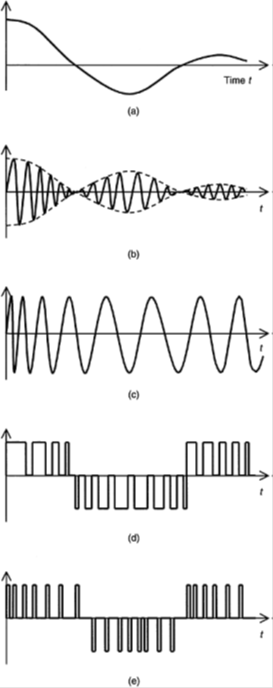SKEDSOFT
Modulators and Demodulators
Sometimes signals are deliberately modified to maintain the accuracy during their transmission, conditioning, and processing. In signal modulation, the data signal, known as the modulating signal, is used to vary a property (such as amplitude or frequency) of a carrier signal.
In this manner the carrier signal is “modulated” by the data signal. After transmitting or conditioning the modulated signal, typically the data signal has to be recovered by removing the carrier signal. This is known as demodulation or discrimination.

A variety of modulation techniques exist, and several other types of signal modification (e.g., digitizing) could be classified as signal modulation even though they might not be commonly termed as such.
Four types of modulation, In amplitude modulation (AM) the amplitude of a periodic carrier signal is varied according to the amplitude of the data signal (modulating signal), frequency of the carrier signal (carrier frequency) being kept constant. Suppose that the transient signal shown in Figure (a) is the modulating signal, and a high-frequency sinusoidal signal is used as the carrier signal. The resulting amplitudemodulated signal is shown in Figure (b).
Amplitude modulation is used in telecommunication, transmission of radio and TV signals, instrumentation, and signal conditioning.
The underlying principle is particularly useful in applications such as sensing and control instrumentation of mechatronic systems, and fault detection and diagnosis in rotating machinery.
In frequency modulation (FM), the frequency of the carrier signal is varied in proportion to the amplitude of the data signal (modulating signal), while keeping the amplitude of the carrier signal constant. Suppose that the data signal shown in Figure (a) is used to frequency-modulate a sinusoidal carrier signal.
The modulated result will appear as in Figure (c). Since information is carried as frequency rather than amplitude, any noise that might alter the signal amplitude will have virtually no effect on the transmitted data. Hence, FM is less susceptible to noise than AM.
Furthermore, since in FM the carrier amplitude is kept constant, signal weakening and noise effects that are unavoidable in long-distance data communication will have less effect than in the case of AM, particularly if the data signal level is low in the beginning. But more sophisticated techniques and hardware are needed for signal recovery (demodulation) in FM transmission, because FM demodulation involves frequency discrimination rather than amplitude detection. Frequency modulation is also widely used in radio transmission and in data recording and replay. In pulse-width modulation (PWM) the carrier signal is a pulse sequence.
The pulse width is changed in proportion to the amplitude of the data signal, while keeping the pulse spacing constant. This is illustrated in Figure (d). Suppose that the high level of the PWM signal corresponds to the “on” condition of a circuit and the low level corresponds to the “off” condition. The pulse width is equal to the on time AT of the circuit within each signal cycle period T. The duty cycle of the PWM is defined as the percentage on time in a pulse period, and is given by
Pulse-width modulated signals are extensively used in mechatronic systems, for controlling electric motors and other mechanical devices such as valves (hydraulic, pneumatic) and machine tools.

(a) Modulating signal (data signal), (b) Amplitude-modulated (AM) signal, (c) Frequency-modulated (FM)
signal, (d) Pulse-width-modulated (PWM) signal, (e) Pulse-frequency-modulated (PFM) signal.